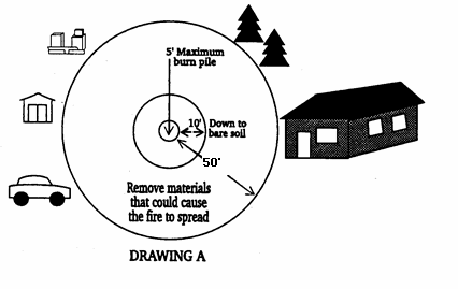- Permittee shall log into the burn permit website prior to burning to verify that no conditions exist under which burning is prohibited and to activate their burn. Permittee shall log back in to the web site at the completion of burning to deactivate their burn. If permittee does not have access to a computer they can visit of call their local fire administration during business hours or call the Regional Communications Center at 928-445-5357 during non-business hours or on holidays.
- Burn Permits shall be valid until the end of the calendar year.
- Residential burning only allows open burning of cut and piled vegetative materials conducted by or for the occupants of residential dwellings, but does not include burning household waste or prohibited material. Burning shall not present a health hazard, generate noxious or toxic fumes, or present a public nuisance.
- Water and other fire fighting equipment/manpower shall be available at the burn site. (e.g. water hose, shovel, etc.)
- The fire shall be attended at all times.
- The fire shall be attended at all times and shall be totally extinguished upon completion of burning.
- Burning shall not be conducted during windy conditions or when winds exceed 15 mph or during any high air pollution advisory.
- Burning shall begin no earlier than one hour before sunrise and fire must be extinguished 2 hours before sunset.
- Prohibited materials shall not be burned. Prohibited materials includes paper garbage from the processing, storage, service, or consumption of food; chemically treated wood; lead-painted wood; linoleum flooring, and composite counter-tops; tires; explosives or ammunition; oleanders; asphalt shingles; tar paper; plastic and rubber products, including bottles for household chemicals; plastic grocery and retail bags; waste petroleum products, such as waste crankcase oil, transmission oil, and oil filters; transformer oils; asbestos; batteries; anti-freeze; aerosol spray cans; electrical wire insulation; thermal insulation; polyester products; hazardous waste products such as paints, pesticides, cleaners and solvents, stains and varnishes, and other flammable liquids; plastic pesticide bags and containers; and hazardous material containers including those that contained lead, cadmium, mercury, or arsenic compounds.
- Materials shall be readily combustible and piled. No vegetation can be burned that has not been cut and piled. The use of torches is prohibited (IFC 308.1.6). No burning shall be started using any flammable liquids.
- The location for open burning shall not be less than 50 feet from any structure, and provisions shall be made to prevent the fire from spreading to within 50 feet of any structure. (see Drawing A below)
- Permit shall be kept at burn location.
- No burning if, written or verbal, order not to burn is issued.

You must be logged in to post a comment.